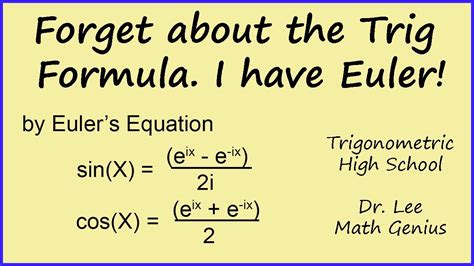A Mathematical Marvel: Unveiling the Essence of Euler’s Formula
Leonhard Euler, the Swiss mathematician and physicist, introduced the groundbreaking formula that bears his name in 1748. This formula has become a cornerstone of mathematics, bridging the realms of complex numbers and trigonometry. It elegantly expresses the relationship between the exponential function and trigonometric functions:

$$e^{ix} = \cos x + i\sin x$$
Where:
- $e$ is the base of the natural logarithm, approximately equal to 2.7182818
- $i$ is the imaginary unit, defined as the square root of -1
- $x$ is a real number
Exploring the Profound Implications of Euler’s Formula
Euler’s formula has far-reaching implications in various mathematical disciplines, including:
- Complex Analysis: It provides a deep understanding of the behavior of complex functions, such as the exponential and trigonometric functions.
- Number Theory: It simplifies the study of prime numbers and their distribution.
- Geometry: It enhances the exploration of curves and surfaces in Euclidean and non-Euclidean space.
Unraveling the Applications of Euler’s Formula in the Real World
The impact of Euler’s formula extends far beyond theoretical mathematics, finding practical applications in fields such as:
- Electrical Engineering: It is used in circuit analysis and the design of electrical systems.
- Computer Science: It plays a crucial role in digital signal processing, image analysis, and cryptography.
- Physics: It contributes to the understanding of quantum mechanics, wave propagation, and other physical phenomena.
Table 1: Applications of Euler’s Formula
| Application Area | Key Uses |
|---|---|
| Electrical Engineering | Circuit analysis, power systems |
| Computer Science | Digital signal processing, cryptography |
| Physics | Quantum mechanics, wave propagation |
A Step-by-Step Guide to Using Euler’s Formula
To harness the power of Euler’s formula, follow these steps:
- Identify the Exponential Function: Determine the exponential function in the given expression.
- Represent it in Trigonometric Form: Convert the exponential function to its corresponding trigonometric form using Euler’s formula.
- Evaluate the Trigonometric Functions: Evaluate the cosine and sine functions using the appropriate trigonometric identities.
Frequently Asked Questions (FAQs)
Q1: Can Euler’s formula be used to find the nth roots of unity?
A1: Yes, by setting $x = \frac{2\pi n}{N}$ in Euler’s formula, we obtain the nth roots of unity.
Q2: How is Euler’s formula related to the sine and cosine functions?
A2: Euler’s formula provides a means to define the sine and cosine functions in terms of complex exponential functions.
Q3: What is the inverse of Euler’s formula?
A3: The inverse of Euler’s formula is given by: $arctan(y/x) = \frac{1}{i} ln(\frac{x + iy}{x – iy})$
Q4: Can Euler’s formula be used to derive identities involving trigonometric functions?
A4: Yes, Euler’s formula can be employed to establish various trigonometric identities, such as $\sin^2 x + \cos^2 x = 1$.
Future Horizons: Envisioning New Applications of Euler’s Formula
The potential applications of Euler’s formula continue to expand, inspiring researchers to explore innovative uses in diverse fields.
- Quantum Computing: Euler’s formula could be employed to develop more efficient algorithms for quantum computers.
- Artificial Intelligence: It might aid in the development of AI systems with enhanced analytical and predictive capabilities.
- Materials Science: Euler’s formula could help optimize the design and synthesis of novel materials with tailored properties.
Table 2: Projected Applications of Euler’s Formula
| Application Area | Potential Uses |
|---|---|
| Quantum Computing | Quantum algorithms, quantum cryptography |
| Artificial Intelligence | Machine learning, deep learning |
| Materials Science | Materials design, nanotechnology |
Table 3: Benefits of Using Euler’s Formula
| Benefit | Description |
|---|---|
| Versatility | Applicable across multiple mathematical disciplines and practical fields |
| Simplicity | Provides concise and elegant expressions for complex relationships |
| Analytical Power | Enhances the understanding and manipulation of complex functions |
Table 4: Challenges Associated with Using Euler’s Formula
| Challenge | Possible Solutions |
|---|---|
| Conceptual Difficulty | Acquire a strong foundation in complex analysis and trigonometry |
| Computational Complexity | Employ efficient numerical methods for evaluating complex exponentials |
| Practical Limitations | Consider the accuracy and precision limitations of digital representations of complex numbers |
By harnessing the power of Euler’s formula, mathematicians, scientists, and engineers can unlock a wealth of knowledge and drive innovation across numerous disciplines. Its versatility and analytical power continue to inspire new discoveries and applications, ensuring its enduring relevance in the ever-evolving world of mathematics.
